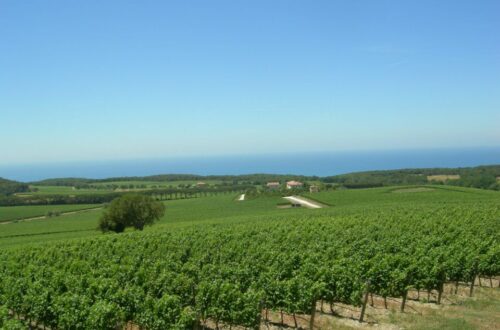Quick Guide to Asolo Prosecco DOCG
- What: Premium Prosecco Superiore DOCG
- Where: 18 hilltop municipalities around Asolo, Veneto
- Grapes: Minimum 85% Glera + local varieties
- Style: Elegant, mineral-driven sparkling wine
- Why it matters: Italy’s most refined Prosecco after Conegliano Valdobbiadene
Table of Contents
What Is Asolo Prosecco DOCG?
Asolo Prosecco DOCG—also called Prosecco Superiore Asolo DOCG—is one of only two premium Prosecco appellations in Veneto, alongside Conegliano Valdobbiadene. Known for its minerality, elegant bubbles, and refined structure, Asolo Prosecco has become a favorite among sommeliers and wine lovers looking for something more complex than standard Prosecco DOC.
History and Origins of Asolo Prosecco
Winegrowing in the hills surrounding the medieval town of Asolo dates back centuries, with references to sparkling wines in local archives as early as the Renaissance. While Conegliano-Valdobbiadene gained fame first, Asolo quietly nurtured its own distinct terroir. In 2009, Asolo was officially elevated to DOCG status, recognizing the superior quality of its wines.
Geography and Terroir
Asolo’s vineyards are carved into the foothills of the Dolomites, where altitude, cool breezes, and mineral-rich soils create sparkling wines with finesse and freshness. The Colli Asolani hills, dotted with cypress trees, olive groves, and medieval villages, give Asolo Prosecco its signature dry, mineral-driven character.
Grape Varieties and Production Rules
Like all Prosecco, Asolo DOCG wines must be made from a minimum of 85% Glera grapes, blended with up to 15% of local varieties such as Bianchetta Trevigiana, Perera, and Verdiso.
DOCG regulations stipulate:
- Maximum yields: Lower than Prosecco DOC, ensuring higher quality.
- Spumante styles: Brut Nature, Extra Brut, Brut, Extra Dry, Dry.
- Unique feature: Asolo is the first DOCG allowed to produce Extra Brut Prosecco, catering to global demand for drier sparkling wines.
Asolo vs Conegliano Valdobbiadene Prosecco
One of the most common searches (and conversations) among wine lovers is: What’s the difference between Asolo and Conegliano Valdobbiadene Prosecco?
- Terroir: Conegliano-Valdobbiadene’s vineyards are steeper and larger; Asolo’s hills are smaller and more compact.
- Style: Conegliano often leans toward fruit-forward, floral expressions, while Asolo is more mineral, structured, and gastronomic.
- Production volume: Conegliano produces far more bottles annually, while Asolo remains a niche choice, often favored by wine insiders.
If Conegliano is the star, Asolo is the connoisseur’s choice.
Key Facts at a Glance
- Appellation: Asolo Prosecco Superiore DOCG (Colli Asolani DOCG)
- Established: 2009
- Region: Veneto, Province of Treviso
- Grapes: 85% Glera + local varieties
- Notable Producers: Montelvini, Bele Casel, Tenuta Amadio
- Alcohol: Typically 11–12%
- Best For: Aperitivo, seafood, light pasta, festive occasions
Tasting Notes
Asolo Prosecco DOCG typically shows:
- Aroma: White flowers, green apple, pear, citrus zest
- Palate: Fine mousse, crisp acidity, distinctive mineral edge
- Finish: Clean, refreshing, with subtle almond notes
Serving & Pairing
- Ideal Temperature: 6–8°C (42–46°F)
- Glassware: White wine glass (better aromatics than a flute)
- Food Pairings:
- Seafood: Venetian-style baccalà, fried calamari
- Vegetables: Asparagus risotto, zucchini fritters
- Cheese: Young Asiago, fresh goat cheese
- Celebrations: Aperitivo hour, weddings, holidays
- Seafood: Venetian-style baccalà, fried calamari
Where to Buy & Pricing
- Price Range: $15–30 (mid-premium tier compared to Prosecco DOC)
- Retailers: Widely available online (Wine.com, Vivino, Eataly) and in specialty wine shops.
- Best value: Look for Brut or Extra Brut bottlings from Bele Casel or Montelvini for authentic Asolo minerality.
FAQ on Asolo Prosecco DOCG
Is Asolo Prosecco better than regular Prosecco?
Yes—Asolo DOCG has stricter production rules and comes from a unique hillside terroir, making it more refined than mass-market Prosecco DOC.
What grapes are used in Asolo Prosecco?
Primarily Glera, with small additions of traditional varieties.
How does Asolo compare to Champagne?
While Champagne is made using the traditional method and offers more complexity, Asolo Prosecco shines for its freshness, elegance, and affordability.
Fun Facts & Cultural Notes
- The medieval town of Asolo is nicknamed “The City of a Hundred Horizons” for its sweeping views.
- English poet Robert Browning fell in love with Asolo, immortalizing it in his poetry.
- Asolo is home to Italy’s first Extra Brut Prosecco DOCG, leading the trend toward drier sparkling wines.
Call to Action
Ready to experience Italy’s most elegant Prosecco? Explore bottles from Montelvini, Bele Casel, or Tenuta Amadio—and taste the difference terroir makes. Join the Drink Italian community for more guides to Italy’s hidden wine treasures.


